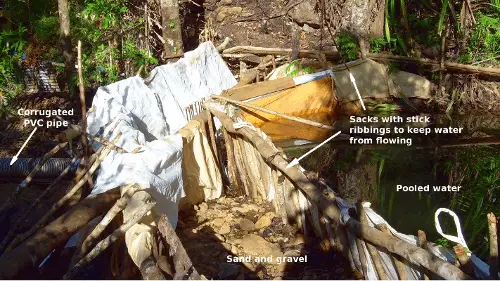Technology can reach remote places and change the way of life of indigenous peoples. Here is an example of cultural diffusionism and acculturation in Sitio Bohoy, a remote place where once G-string clad Pala’wans reside.
I never expected to see a trace of technological innovation in a very isolated place like Sitio Bohoy in the far-south of Palawan Island in the Philippines two years back. More so aware of the fact that those who employ such technology belong to the indigenous people, the Pala’wans, who were once wearing G-strings the last time I recalled seeing them.
How the Mini-Hydro Came to Be
Boyet, a member of the Pala’wan tribe, came up with his own version of the mini-hydroelectric power station to provide electrical power to 15 houses in his community. Together with his friends, he built a dam in a nearby stream made of indigenous materials plus junks he could lay his hands on from the materials recovery facility of a nearby mining company.
The makeshift mini-hydro dam pooled water and produces power when water is released through 6-inch corrugated PVC pipes at the main source, then smaller pipes downstream to increase water pressure. This series of big and small pipes are joined together by rubber strips, probably from worn-out rubber tires of vehicles. A two-inch GI pipe at the end of the pipeline hits the home made turbine attached to a generator that consequently produces electricity at the onset of darknesss until 10 pm. Occasionally, along the length of the pipeline, holes with small hoses inserted in it supply water in the adjoining farms.

Is the mini-hydro an original invention? Of course not, but it arose through simple diffusion of technology.
When our group asked him how we was able to conceptualize the mini-hydro, he simply said “I saw it on TV.” His large television set, presumably one of those cheap, surplus televisions from Japan, once gets its power from a 12-volt truck battery. Now, the electricity generated by the mini-hydro powers the television including a karaoke. This turned the once quiet nights of the community into nights of singing and merrymaking.
Cultural Diffusionism and Acculturation
What struck me upon seeing the makeshift mini-hydro is the influence this technology can impose on the culture of the indigenous tribe – the Pala’wan. Technology diffused to this community through the television gradually worked its way into their way of life, changing their once unique heritage of cultural mores and beliefs. This is a classic example of cultural diffusionism, defined by Titiev (1958:446) as the spread of a cultural item from its place of origin to other places.
I bring up this issue remembering the discussion I had with an anthropologist during one of the training I attended two years ago. She said that she would like to study the indigenous tribes of Palawan. But I said, those indigenous groups no longer exist, knowing that many of them intermarried with immigrants and citing this particular story.
The Pala’wans have already been acculturated. Theirs is a polluted culture. Wouldn’t you agree?
Reference:
Titiev, M. (1958). Introduction to Cultural Anthropology. New York: Henry Holt and Co.
© 2013 July 6 P. A. Regoniel

